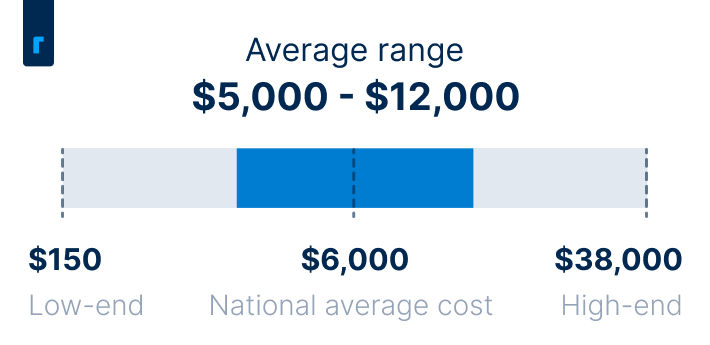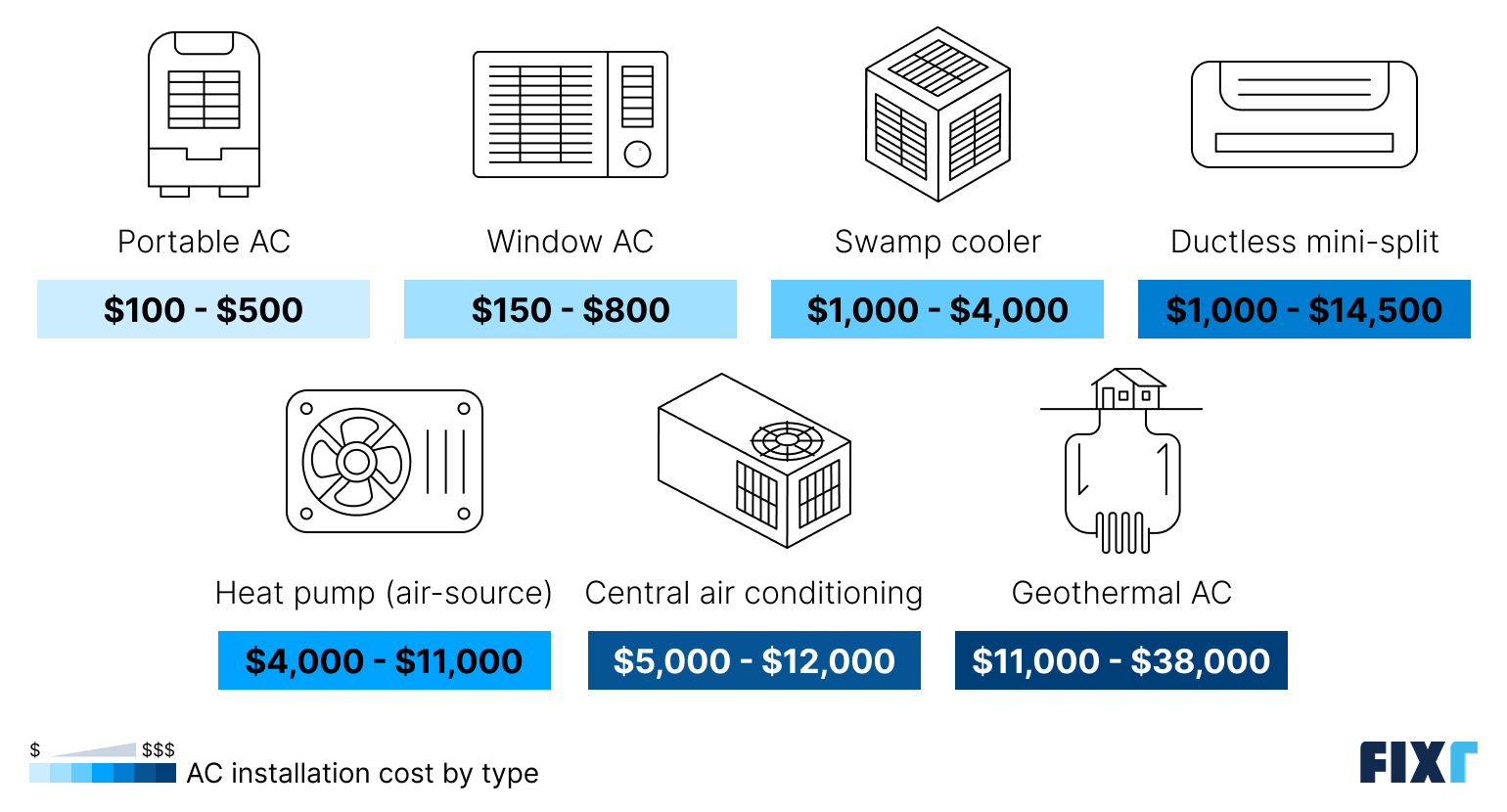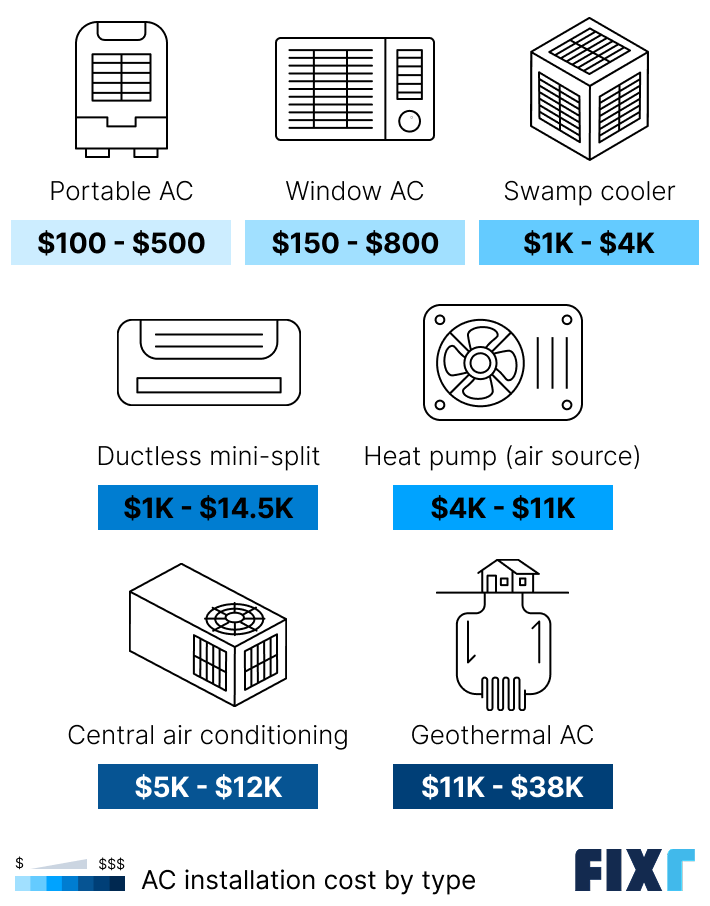Updated: August 29, 2025
Written by Dan Simms
Laura Madrigal is the Home Design Specialist at Fixr.com, dedicated to identifying and analyzing significant changes within residential design. She is the author of leading trends reports on interior design, kitchen, and bathroom, and her insights have been featured in publications like Realtor and the New York Post.
Learn moreReviewed by Laura Madrigal
If you’ve noticed that your home isn’t as cool and comfortable as it used to be, or that your utility costs in the warmer months are creeping higher and higher, you may need to consider a new AC system. A new AC installation can significantly improve your home's energy efficiency, reduce cooling costs, and provide comfort, ensuring you stay cool when you need it most.
The average cost to install a new AC system is $6,000, and most homeowners pay somewhere between $5,000 and $12,000. The average cost represents materials and labor to install a 3-ton central AC unit, which is the most common type of AC system and an appropriate size for the average-sized home. Your costs could fall anywhere from $150 for a small window AC to $38,000 or more for a geothermal heat pump that provides both heating and cooling.
New Air Conditioner Cost


Air Conditioner Installation Cost by Type of Unit
The cost to replace an AC unit is going to depend mostly on the type of AC you’re considering.


Type of AC | Average Cost |
Portable AC | $100 - $500 |
Window AC | $150 - $800 |
Swamp cooler | $1,000 - $4,000 |
Ductless mini-split | $1,000 - $14,500 |
Heat pump (air-source) | $4,000 - $11,000 |
Central air conditioning | $5,000 - $12,000 |
Geothermal AC | $11,000 - $38,000 |
Window and Portable AC
Window ACs and portable ACs are the most affordable options. You can pay anywhere from $100 to $800 per unit you need, and most homeowners install them themselves. These are temporary and offer the lowest efficiency and power for small areas only.
Swamp Cooler
Swamp coolers, or evaporative coolers, cost between $1,000 and $4,000 to install. They’re some of the most efficient AC systems available because they don’t need to condense refrigerant to provide cooling. They need minimal maintenance, but they’re only suitable in mild climates that mostly experience low humidity levels.
Ductless Mini-split
Ductless mini-splits also use outdoor condensers but have indoor wall-mounted units to distribute air to smaller areas. They don’t require ductwork, making them popular in homes without ducts. They’re highly energy-efficient and provide precise cooling, and many can handle heating, too. Installing ductless mini-splits can cost anywhere from $1,000 to $14,500 or more, depending on how many units you need.
Air Source Heat Pump
Air source heat pumps are more popular than geothermal systems because they offer similarly high efficiency at a much lower cost. These will run you between $4,000 and $11,000, in most cases. Air source heat pumps can also provide heat, so you could save on heating system replacement costs if you go with an air source heat pump that can handle both heating and cooling.
Central AC
Central AC systems, also called split AC systems, are the most common, and the cost to install central air averages between $5,000 and $12,000 for the typical home. These systems use an outdoor condenser to move refrigerant and an indoor air handler that distributes cooled air through ductwork. This is a popular option for homes with furnaces that are already fitted with ductwork, as they are highly efficient for whole-home cooling.
Geothermal Heat Pump
Geothermal heat pumps can provide both heating and cooling and are extremely efficient for both purposes. However, they require large-scale excavation, which makes them the most expensive options. Expect to pay between $11,000 and $38,000 for the materials and labor, depending on the size of your home. They’re expensive, but they have low running costs, minimal maintenance requirements, and last longer than most other types.
Average Cost to Install Air Conditioning by Unit Size
AC system sizes are measured in tons or British thermal units (BTUs), with 1 ton being the equivalent of 12,000 BTUs per hour.
Systems with a higher tonnage or BTU rating will be able to cool larger spaces, but bigger isn’t always better. You really want your AC’s capacity to match the area you’re looking to cool. An AC that’s too small won’t keep your living space comfortable, and it will work overtime to try to keep up with demand, which leads to more maintenance and a shorter lifespan. An AC that’s too large will cycle on and off rapidly, which can kill the compressor and shorten the system’s lifespan. An oversized AC will also often lead to uneven cooling in your home.
AC tonnage is loosely based on home square footage, with the average home needing 45 BTUs per square foot of living area. You can use the table below to get an idea of what a properly-sized AC will cost for your home, but always hire a pro to determine your final system size. An expert can use a Manual J calculation that takes other sizing factors into consideration, like your local climate, ceiling height, sun exposure, insulation efficiency, home age, and more.
The initial cost for an AC unit is higher for larger models, especially for types like ducted central air.
Tons | BTUs | Average Cost |
1.5 | 18,000 | $1,800–$7,000 |
2 | 24,000 | $2,000–$7,600 |
3 | 36,000 | $2,500–$8,000 |
4 | 45,000 | $3,100–$8,700 |
5 | 60,000 | $3,300–$9,300 |
Labor Cost to Install AC Unit
On average, you can expect to pay between $500 and $2,500 for the labor to install a standard central AC system, or between $75 and $250 per hour. Labor costs include installing your unit, running any necessary wiring, running new refrigerant lines, and testing your system. Some techs will also include the cost of removing your old unit and hauling it away, but many will not.
Labor costs vary widely based on the type of system you install. Most homeowners don’t hire a professional for window and portable ACs, as there is little to no labor required, while the labor costs to install a geothermal heat pump can total over $15,000. They also vary based on the complexity of your particular installation, local labor rates, and the time of year.
Additional Air Conditioning Installation Cost Factors
The type and size of the AC you install are the most significant cost factors to consider, but there are many other things you should consider to get the most accurate price possible.
Pre-installation evaluation: Ideally, you want your HVAC tech to complete a Manual J load calculation to size your AC perfectly. Some installers will charge for this, but they may waive the fee if you move forward with their estimate.
Seasonal Energy Efficiency Ratio (SEER) rating: AC units come with different efficiency levels, typically measured by SEER or SEER2. Higher-efficiency models cost more upfront but save you more over time—especially in hot climates. These models often include advanced features like variable-speed motors for better comfort and quieter operation.
Ductwork installation or modification: If you don’t already have ductwork installed and need it for your new system, expect to add between $1,400 and $6,000 to your total. If you have ducts already, you may just need repairs or a duct cleaning, which can still add hundreds to your total.
Permits and fees: Most municipalities require permits for changes to mechanicals, including AC replacement and installation. Permit fees can range from $50 to $1,500, depending on the type of AC and your building department’s fee schedule. Note that installing a window or portable AC won’t require a permit.
Warranty: Most AC manufacturers offer some kind of warranty for general parts and a separate warranty for the compressor, and some HVAC companies will offer a labor warranty covering their installation labor. Generally speaking, you’ll pay more for units and installers with longer and more comprehensive warranty coverage.
Urgency of work: Most HVAC techs will charge more if you need an emergency AC installation or replacement in the dead of summer, especially if you need the work done on a weekend or holiday. The added fee for the inconvenience could end up totaling hundreds of dollars.
Number of zones: Whole home AC systems are often zoned to provide more precise temperature control and reduce unnecessary cooling of unused spaces, like bedrooms, during the day. The more zones you need, the more labor it will take to install everything, and the more you’ll pay. The same is true for ductless mini-splits. These have “built-in” zones since the interior units each serve a specific section of your home, but the more you need installed, the higher your total will be.
Access and infrastructure: You may pay more in labor costs if your existing equipment or the area where you want your new equipment is challenging to access. This could include tight utility closets or attics with limited space that make moving equipment and tools more time-consuming.
Insulation: Good insulation in your home can affect the long-term running costs for your AC system and even the longevity, so many homeowners consider insulation upgrades alongside AC installation. Upgrading insulation can add hundreds or even thousands to your total, depending on your home size, insulation type, and climate.
AC Replacement Cost vs. Repair
Repairing an AC is almost always going to cost less than replacing it. AC repairs cost an average of $375, while central air installation costs an average of $6,000. If your AC is under 10 years old and your repair estimate is under $4,000, a repair is probably best. If your AC is older than a decade, repairs exceed 50% of the replacement cost, or you’ve had ongoing problems with your unit, replacing it will still cost more but is likely the better financial option in the long run.
Here are some signs you may need to replace your AC system sooner rather than later:
Ongoing issues: You may benefit from an AC replacement if you’re dealing with repeat issues. Consider replacing your system if you find yourself calling an HVAC tech annually for anything other than a tune-up.
Unusually high energy bills: AC systems lose efficiency as they age, so if your utility bills are increasing unexpectedly during the hotter months, it could mean your AC is working harder than it should to cool your space.
Uncomfortable indoor temperatures: For the same reasons, you may find that your system just doesn’t cool your home as well as it used to, which could mean it’s time for a replacement.
It’s nearing the end of its useful life: Check the expected lifespan of your type of AC. If your unit is within a few years of the upper end of the range, a replacement is probably a good idea before it fails.
You also need to replace your heating system: If you have an issue with your heating system and you also know your AC is aging, it might be a good time to consider a new system that can provide both heating and cooling for maximum comfort and efficiency year-round.
DIY AC Work vs. Hiring a Pro
Installing a window or portable AC is easy enough for most homeowners to tackle themselves, and it’s rare to hire a pro for these types. However, any other AC system demands help from a professional. An expert can size your system appropriately, ensure a safe installation that doesn’t result in damaged or under-performing equipment, and make recommendations for features, system types, and even other home upgrades to help you get the most out of your new AC unit.
DIYing whole-home AC systems or even ductless mini-splits involves working with refrigerant, which is strictly regulated, and most municipalities will only issue permits to licensed contractors. As such, it’s often not legal to install your own AC. Even if it was, DIYing can void your warranty and lead to electrical issues and water damage due to improper installation. Hiring a pro is expensive, but it’s always worth it in the long run.
When it comes time to choose an HVAC tech to handle your AC installation, start by asking friends, family members, or neighbors for recommendations. Read through online reviews, confirm proper licensing, and check the BBB for red flags. Then, get a quote from each company you’re considering. Avoid companies that offer estimates without an inspection, as well as companies that come in well below-average on pricing.
Ways to Save on AC Installation Costs
Installing a new AC system can be quite expensive, but there are some things you can do to reduce your upfront and long-term costs.
Choose an energy-efficient unit: AC systems with higher levels of efficiency will usually cost more upfront, but they can save you money over time on your cooling bills, especially if you live in an extreme climate.
Look for incentives and rebates: ENERGY STAR-rated air conditioners may qualify for incentives, like the Energy Efficient Home Improvement Tax Credit from the federal government. Check the Database of State Incentives for Renewables and Efficiency (DSIRE) for information on state and local incentives, too.
Get at least three estimates: Shop around for an HVAC contractor and get at least three estimates. Compare these based on the quality of the equipment and the overall cost to find the best value.
Time your installation properly: HVAC contractors are busiest in the summer and winter, so if you can wait, aim to get your AC replaced in the spring or fall. You may enjoy lower labor costs due to the decreased demand.
Have a Manual J load calculation done: Be sure to ask your contractor to complete a Manual J load calculation when sizing your system. This will ensure you don’t over- or under-size your system, which could lead to inefficiencies and a shorter unit lifespan.
Get a system that can also handle heating: If you also need to replace your heating system, you can save on your total for both systems by choosing a heat pump or ductless mini-splits that can provide both heating and cooling.
FAQs
An air conditioner for a 2,000-square-foot home will cost an average of $6,000 if you go with a central AC system, but prices can fall anywhere between $5,000 and $12,000. Your costs will vary based on your local climate, your home’s age and energy efficiency, and more. If you choose a different type of AC system, your costs could fall well outside of that range.
According to the U.S. Department of Energy, 12% of a home’s annual electricity consumption goes toward AC usage, and based on the average monthly electric bill in the country, that means homeowners spend $16.42 per month or around $0.55 per day, on average. This can range widely based on the type of AC system you have, the efficiency rating, your cooling needs, and your local climate. Prices can be significantly higher in hot climates.
The $5,000 rule for HVAC is a way to determine if a repair or replacement is a better investment over the long run. Once you have a repair estimate in hand, multiply the total by the age of your unit in years. If that number is higher than $5,000, then the rule states that a replacement is a better choice. This is just a rule of thumb, though, so ask your HVAC tech what they recommend.
Central ACs are the most common type of ACs in the U.S., with around 60% of all homes being equipped with this style. However, the best type of AC depends on many factors, including your cooling needs, your home size, whether you also need heating, your budget, and more. Ductless mini-splits are an increasingly popular option and can be a better investment for more localized cooling, especially if you also need heating. Speak with your HVAC professional for help deciding which type is right for you.
The lifespan of an AC unit can range anywhere from 8 to 25 years, depending on the type of AC. Window units last for 8 to 12 years, ductless mini-splits and air source heat pumps can last for 10 to 20 years, central AC systems last for 15 to 20 years, and geothermal heat pumps can last for up to 25 years. The climate in which your AC is operating, the demands you place on it, and how diligent you are about routine maintenance will all affect the lifespan.
